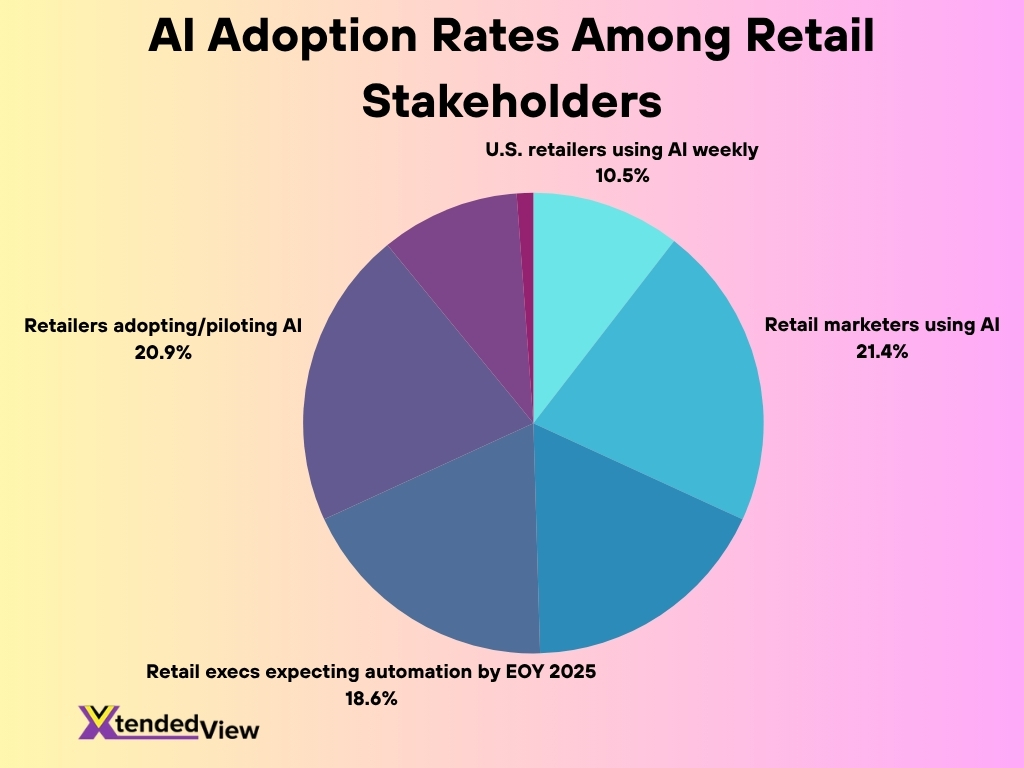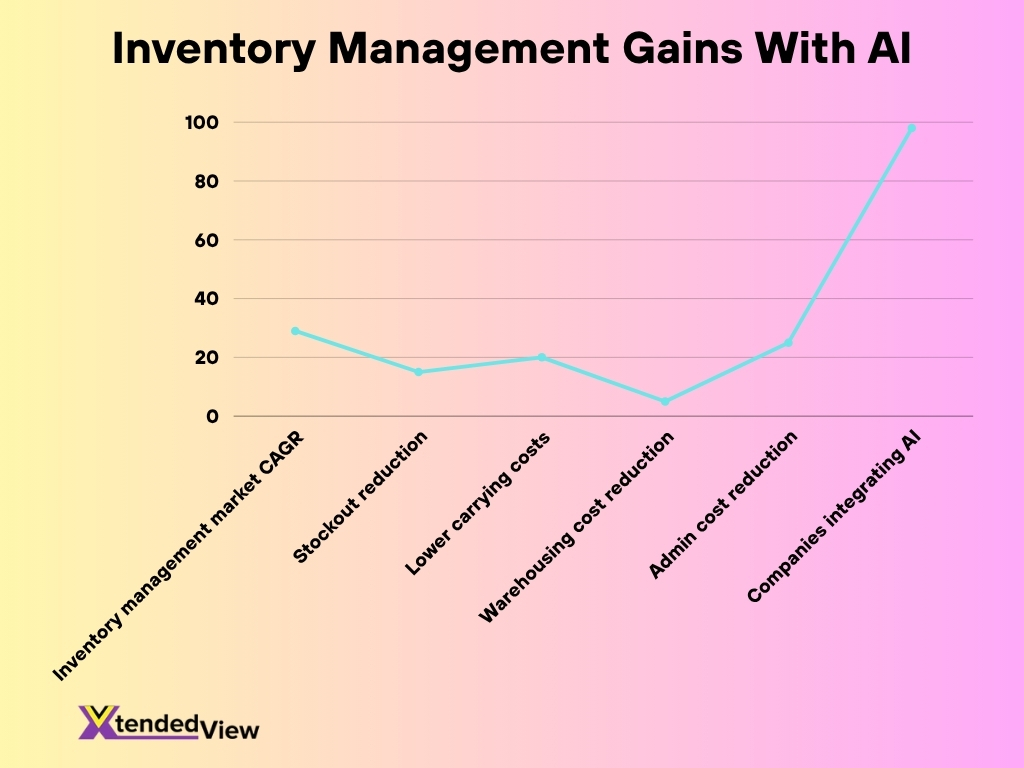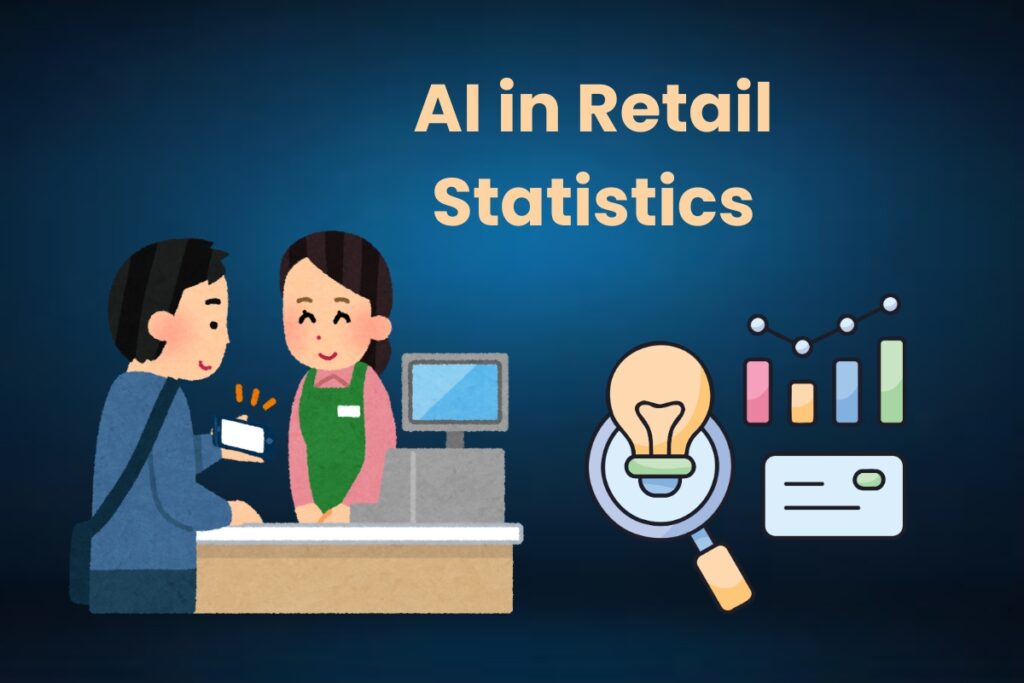Introduction
Retailers today are turning to artificial intelligence not just for novelty, but to power smarter operations, sharper personalization, and cost control. AI is already influencing everything from product recommendations to warehouse logistics. In practice, a fashion e-tailer might use AI to tailor outfits based on real-time user behavior, while a grocery chain applies computer vision to speed up checkout. Read on to see how hard numbers back this shift.
Editor’s Choice
Here are seven standout statistics that set the stage:
- 92 % of retail marketers now use AI in their workflows (2025).
- 76 % of retailers say they plan to increase AI investment in the near term.
- In 2025, AI in retail market size is forecast at USD 14.24 billion.
- 9 out of 10 retailers are either adopting or piloting AI solutions.
- Retailers using AI reportedly achieve 2.3× higher sales vs non-adopters.
- In field experiments, Generative AI increased firm productivity by up to 16.3 %.
- Only 11 % of retailers say they’re ready to scale AI across the business.
Recent Developments
- Walmart announced a partnership with OpenAI to let customers shop via ChatGPT with an “Instant Checkout” feature.
- In 2024, AI-influenced online holiday sales in the U.S. rose 4 % year over year, reaching USD 282 billion.
- Chatbot usage by consumers jumped 42 % year over year during the 2024 holiday season.
- Across industries, only 5 % of companies are deriving measurable value from AI investments.
- The trend of agentic AI (autonomous decision agents) is gaining ground in retail architectures.
- Some retailers report integrating AI into core operations, not just experiments.
- Experiments on generative AI in retail show conversion and productivity gains of up to 16.3 % for select workflows.
- Several large retailers are piloting computer vision, agent agents, and AI text generation across in-store and online channels.
AI Adoption Trends in Retail
- 45 % of U.S. retailers use AI at least weekly, but only 11 % say they’re ready to scale it business-wide.
- 92 % of retail marketers use AI in 2025.
- 76 % of retailers plan to increase AI investment in the coming year.
- 80 % of retail executives expect their firms to adopt AI automation by the end of 2025.
- 9 in 10 retailers are adopting or piloting AI deployments.
- Among top AI-spending sectors, retail ranks among the top quartile.
- According to McKinsey, 42 % of business functions, such as sales and marketing, now use generative AI tools.
- Retailers still lag in maturity, with only 5 % of companies extracting measurable value per major consulting reports.
- Many deployments remain experimental or departmental rather than enterprise-scale.

Market Size and Growth of AI in Retail
- In 2025, the global AI in retail market is projected to be around USD 14.24 billion.
- Other estimates place it near USD 15.3 billion with a CAGR of 36.6 %.
- The broader AI market size is forecast at USD 243.7 billion in 2025.
- Some analysts see retail AI growing to USD 96.13 billion by 2030 from a 2025 baseline.
- Retail eCommerce total sales in 2025 are forecast at USD 7.5 trillion globally.
- Digitally influenced sales already exceed 60 % of total retail in 2025 forecasts.
- AI deployment in marketing alone is rising, with 55 % of U.S. retail marketers planning to increase AI spend in 2025.
- Retailers anticipate rapid scaling, with 76 % planning to increase AI investment next year.
- Even with growth, few are fully ready, as 11 % of retailers say they can scale AI across the business.

Impact of AI on Retail Revenue and Cost Savings
- Retailers that use AI have seen 2.3× higher sales compared to peers without AI.
- These same adopters report 2.5× better profit growth vs non-users.
- In controlled experiments, Generative AI increased productivity by up to 16.3 %.
- 43 % of surveyed retailers see improved insights and decision-making due to AI.
- 42 % of retailers cite enhanced employee productivity from AI.
- AI-influenced holiday sales in the U.S. grew to USD 282 billion in 2024, up 4 % year over year.
- Chatbots and virtual assistants drove 42 % higher usage during the holiday season.
- In one field study, firms held inputs constant but got sales lift via AI, showing direct productivity gains.
- Analysts envision Amazon’s AI assistant Rufus delivering USD 700 million in operating profit in 2025.
AI-Powered Personalization in Retail
- 46 % of marketers expect AI to significantly boost personalization capabilities in coming months.
- Retailers using AI-driven personalization report a 1.3× lift in incremental ROAS (return on ad spend).
- Early trials by top retailers show a 10 % to 25 % increase in ROAS via AI personalization.
- Retailers that deploy advanced personalization see up to a 40 % increase in average order value (AOV) and 30 % higher conversion rates versus generic experiences.
- 59 % of shoppers say they often see repeated ads, motivating more refined AI personalization in 2025.
- 61 % of marketing executives believe generative AI will strengthen customer personalization and engagement efforts.
- By 2025, 80 % of customers are more likely to buy when brands offer personalized experiences.
- 46 % of marketers worldwide plan to use AI to personalize content in the next 12 months.
- As ad costs rise, tailored marketing via AI becomes more critical to maintain relevance.
Inventory Management and Optimization With AI
- The AI in the inventory management market is growing fast, from USD 7.38 billion in 2024 to USD 9.54 billion in 2025, a CAGR of ~29.2 %.
- Retailers using AI forecasting report 15 % fewer stockouts on average and 20 % lower carrying costs for excess inventory.
- AI can reduce warehousing costs by 5–10 % and administrative costs by 25–40 %.
- 98 % of companies in Q1 2025 say they integrate AI into their supply chains for forecasting and inventory optimization.
- Smart inventory systems combine AI and sensor tech for real-time visibility and auto replenishment.
- AI agents are expected to increasingly manage inventory decisions with less human oversight.
- Many retailers integrate external signals like weather, local events, and trends into inventory AI models.
- Some case studies show inventory turnover improvements and reduced dead stock via AI algorithms.
- AI systems help shift from periodic to dynamic replenishment according to demand variation.

Demand Forecasting With AI
- AI demand models often improve forecast accuracy by 10 %–20 % over traditional methods.
- By analyzing sales, promotions, weather, and external signals, AI models adapt faster and anticipate trends.
- AI in demand planning is used in more than twice as many top-performing supply chain organizations as low-performing ones.
- AI-driven demand forecasting helps maintain ideal stock levels while minimizing overstock or shortage.
- Many retailers now run “what-if” simulations using AI to test scenarios.
- In volatile product categories, AI forecasts help compensate for fast shifts in demand dynamics.
- Retailers integrating demand forecasting AI reduce planning errors and inventory waste.
- AI systems continuously refine models based on real outcomes, not static schedules.
- Some forecasts suggest that by 2026, over 75 % of enterprises will adopt AI across their supply chains.
Dynamic Pricing and Price Optimization Using AI
- AI algorithms dynamically adjust prices based on demand, inventory, and competitor pricing.
- Retailers using AI pricing tools report increases in margin capture and reduced discount waste.
- Some systems can update prices in real time in response to shifts in demand.
- AI optimization can test multiple price points and select the one with highest expected margin.
- Through A/B testing and price elasticity modeling, AI yields higher revenue per SKU.
- In fast fashion categories, AI dynamic pricing helps reduce markdown losses and stock obsolescence.
- Some AI platforms help retailers respond quickly to competitor changes and market signals.
- Predictive price models reduce price volatility while preserving competitiveness.
Visual Search and Image Recognition in Retail
- Visual search (snap a photo → find product) gains traction in mobile shopping.
- AI image recognition helps flag products from user photos, enabling direct purchase paths.
- Some brands estimate visual search can reduce search abandonment rates significantly.
- Use of smart mirrors augmented with AI helps suggest colors, combos, and sizes in fitting rooms.
- Visual recognition also helps automate tagging, categorization, and catalog enrichment.
- Stores embed camera systems to track shopper movement and optimize layouts.
- AI systems can detect fraudulent image usage or counterfeit goods via image matching.
- In fashion and furniture domains, visual search adoption is faster due to high visual appeal.
Conversational AI and Chatbots in Retail
- In the 2024 U.S. holiday season, shoppers used AI chatbots 42 % more year over year.
- AI agents are becoming a primary investment, with 76 % of retailers saying they will increase investment in AI agents in the next year.
- Analysts predict AI assistants will handle up to 20 % of eCommerce tasks in 2025.
- Chatbots manage inquiries, returns, order tracking, and upsell cross sells around the clock.
- Conversational AI helps reduce customer service costs by automating low-level queries.
- Some retailers integrate bots in messaging apps, voice assistants, and web chat simultaneously.
- Usage of conversational AI can shorten resolution times and improve CSAT scores.
- Retailers report higher conversion rates when chat is embedded during shopping journeys.
Retail Supply Chain and Logistics Optimization
- AI is central to optimizing supply chain decisions like demand, route, sourcing, and replenishment.
- Algorithms help minimize delays and disruptions by dynamically rerouting shipments.
- Some logistic networks use AI to optimize last-mile delivery paths and cluster shipments.
- AI can forecast supply shocks like delays or raw material issues and trigger contingency plans.
- Inventory flows between warehouses and stores are balanced using AI to avoid over or under supply.
- AI models incorporate external indicators such as weather or geopolitical events to adjust logistics plans.
- Efficient logistics via AI reduce shipping costs, fuel usage, and carbon footprint.
- AI-driven network optimization also improves distribution center placements and throughput.
Fraud Detection and Security Through AI
- Global e-commerce fraud rose about 21 % year-on-year in 2025, driven by more AI-assisted attacks.
- AI-driven fraud attempts made up 60.5 % of reported fraud in some sectors in 2025.
- The U.S. AI in fraud detection market is estimated to reach USD 5.1 billion in 2025.
- The global AI fraud detection market is projected to reach USD 31.69 billion by 2029, at a CAGR of ~19.3 %.
- 93 % of industry respondents believe AI will revolutionize fraud detection, and nearly all are already using AI in fraud controls.
- In 2023, reported fraud losses exceeded USD 10 billion, up 14 % from 2022.
- E-commerce businesses lose roughly 3.5 % of annual revenue to fraud globally.
- Advanced techniques like GANs and deep learning now detect deepfake or synthetic fraud with detection rates above 95 % in experimental settings.
- Many merchants plan to prioritize improving AI/ML fraud tool accuracy and automation in 2025.
AI-based systems now analyze behavior signals, device fingerprints, transaction context, and anomaly scores in real time to block malicious activity, while fraudsters are also leveraging AI tools for spoofing, synthetic identities, and deepfake attacks, which means retailers must counter with defenses that learn, adapt, and scale.
Automated Content Generation in Retail
- In 2025, more retailers are using generative AI to draft product descriptions, marketing emails, and social content, cutting human editing time.
- Some brands report 30 %–50 % faster content output when using AI assistants.
- AI content tools help localize messaging by region, reducing translation overhead.
- Automatic tagging and SEO enrichment using AI boosts discoverability with less manual labor.
- AI systems generate customized landing pages or ad creatives based on user segments.
- Retail press releases, blogs, and newsletters are increasingly drafted via AI, requiring only light edits.
- Generative AI experiments suggest 10–15 % gains in engagement over traditional content.
- Combined with personalization layers, AI-generated content can adapt in real time for better resonance.
This shift allows retailers to scale content creation without proportional investments in human writers, enabling more frequent campaigns, tests, and versions.
AI-Driven Merchandising and Store Layouts
- Retailers use AI to simulate store layouts using foot-traffic heatmaps and conversion data.
- Some brands report 5–10 % uplift in in-store sales by repositioning hot SKUs via AI guidance.
- AI helps cluster products that sell better together, optimizing adjacency or bundling decisions.
- Merchandising AI can test scenarios like swapping categories or changing shelf order in virtual environments before rollout.
- Predictive models guide when to rotate or replace displays for maximum freshness.
- AI also supports planogram generation, automatically adjusting shelf space allocation by demand signals.
- Cross-channel merchandising is consistent, online and offline assortments align via AI recommendations.
- AI can detect underperforming SKUs and suggest markdown or removal earlier, reducing dead inventory.
Sustainability and Waste Reduction With AI
- AI is helping retailers reduce waste and overproduction by aligning supply with demand more precisely.
- Some firms deploy AI to optimize packaging, reducing materials and shipping weight.
- AI-enabled logistics optimization reduces fuel usage and carbon emissions through smarter routing and consolidation.
- Renewable energy forecasts and emission penalties are integrated into AI supply models, improving long-term sustainability decisions.
- AI supports circular economy models, forecasting returns, refurbishing paths, and resale strategies.
- Retailers use AI to detect spoilage or expiration in perishable goods and dynamically discount or reallocate stock.
- Some brands use AI to track lifecycle emissions of products and flag high-impact items for redesign.
- AI now minimizes waste, optimizes production, and ensures compliance with sustainability goals.
By making operations more efficient and less wasteful, AI becomes not just a cost tool, but a lever for greener retail.
Challenges of Implementing AI in Retail
- 30 % of generative AI initiatives will be abandoned by end of 2025 due to data, cost, and unclear value.
- Many retailers struggle with poor data quality or fragmented systems, a major barrier to scaling AI.
- Data privacy, security, and compliance are top concerns when deploying AI solutions.
- Integration with legacy systems presents complexity, especially for mid-tier retailers.
- Talent shortage, as retail firms often lack AI expertise in-house.
- ROI is uncertain, many pilots don’t move to full-scale production, leaving sunk costs.
- Bias and transparency, AI models may behave unpredictably or unfairly.
- Change management, employees might resist AI when workflows shift.
- Operational overhead, model retraining and monitoring drift add maintenance burdens.
These challenges make it essential for retailers to adopt AI thoughtfully, starting small, prioritizing data hygiene, and building internal capabilities.
Future Trends of AI in Retail
- Agentic AI (autonomous decision systems) will increasingly run micro-operations like dynamic restocking or promotional bidding with minimal human oversight.
- Multi-modal AI agents combining vision, language, voice, and behavior signals will offer richer customer interactions.
- Retailers will adopt self-optimizing systems, where inventories, pricing, content, and layout co-evolve in feedback loops.
- Edge AI will move processing closer to stores or devices to reduce latency and preserve privacy.
- AI will support hyperlocal retailing, predicting foot traffic and local events to tailor assortments and offers.
- Blockchain + AI may better trace provenance, authenticity, and supply chain transparency.
- AI will embed sustainability goals by design, factoring emissions, waste, and circularity into decisions.
- Collaborative AI networks may emerge across retailers, sharing anonymized models to improve fraud detection, demand forecasting, or trend insight.
- Explainable AI (XAI) must mature so retailers can interpret and trust AI decisions, especially for merchandising, pricing, and security.
The next frontier is not just applying AI, but creating self-driving retail systems that learn, adapt, and co-evolve with markets.
Frequently Asked Questions (FAQs)
It’s forecast at about USD 14.24 billion.
A compound annual growth rate of roughly 32-33 % is projected.
92 % of retail marketers report using AI.
43 % are piloting agentic AI, and 53 % are evaluating it.
Gains reached up to 16.3 % in certain workflows.
Conclusion
AI’s influence in retail is no longer emerging; it’s essential. From fraud detection that catches sophisticated attacks, to generative content, layout optimization, and sustainability planning, AI is shaping nearly every dimension of retail operations. Yet the path to full adoption is fraught with data, integration, transparency, and talent challenges. Retailers that tread carefully, starting with high-impact pilots, cleaning data, building internal capabilities, and embracing small wins, can reap outsized gains.


